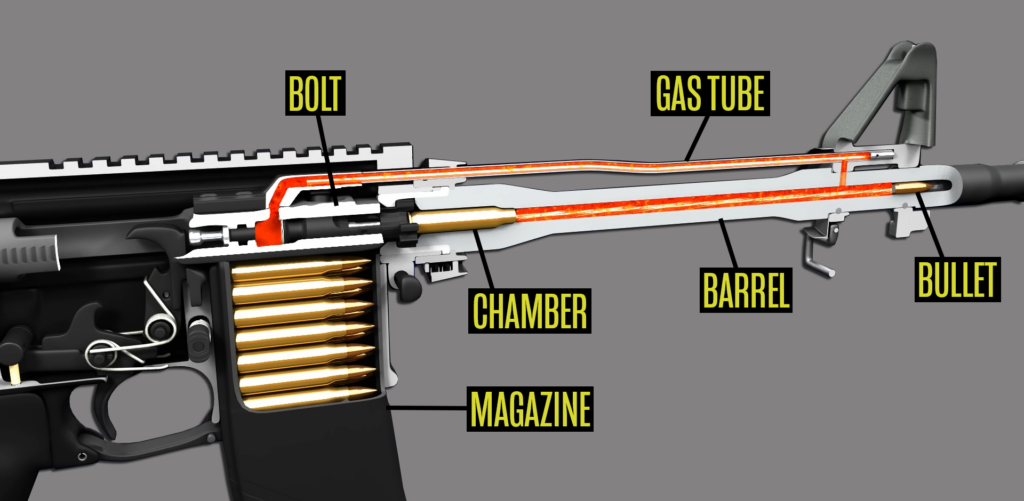On Thursday, Senators Martin Heinrich (D-NM), Angus King (I-ME), Mark Kelly (D-AZ), and Michael Bennet (D-CO) introduced new legislation — the Gas-Operated Semi-Automatic Firearm Exclusion (GOSAFE) Act — that would prohibit gun makers from producing new semi-automatic rifles that use gas operating systems, including AR-15s and AK-47s, the types of weapons that have been used to commit the deadliest mass shootings across the country. The GOSAFE Act would also prohibit new large-capacity magazines (LCMs) that hold over 10 rounds of ammunition from being manufactured, sold, or transferred after its enactment as well as any device designed to increase a semi-automatic weapon’s rate of fire — such as “Glock switches” and bump stocks.
The proposed legislation comes after a gunman likely used a Ruger AR-10 with multiple 20-round magazines to kill 18 people and wound another 13 in Lewiston, Maine in October.
GAS OPERATION BASICS
The term “gas operated” refers to firearm operating systems where the gas generated from firing a round is used to load subsequent rounds into the chamber — all of which happens in milliseconds, allowing mass shooters to unleash rapid-fire barrages on unsuspecting victims. All semi-automatic rifles today, including AR-15s and AK-47s, use gas operating systems with slight variations.
In essence, firing a bullet creates a tiny explosion that releases high-pressure gas that pushes the bullet down the barrel. In an AR-15, as shown below, that gas is vented into the gas tube and redirected back toward the bolt. The gas impacts the bolt and drives it rearward so it can eject the spent cartridge casing from the chamber. A spring then pushes the bolt forward so it can strip a new cartridge from the top of the magazine and load it into the chamber. Now the gun is ready to fire again.

How GOSAFE Compares to Other Laws
By targeting how semi-automatic rifles operate, the GOSAFE Act is unlike the assault weapons bans currently in effect in 10 states and Washington, D.C., which generally mimic the former federal ban in prohibiting certain assault weapons based on their military-style features, such as pistol grips and threaded barrels. For years, the gun lobby has argued — incorrectly — that these features are merely “cosmetic,” even though pistol grips make it easier to handle a rifle with one hand and in close quarters, for example, and threaded barrels allow shooters to install silencers on their weapons.
In this way, the GOSAFE Act would prevent manufacturers from producing the “state-compliant” AR-15 and AK-47 workarounds that are sold in states with assault weapons bans — including “featureless” models lacking the proscribed features and fixed-magazine models that must be partially disassembled to be reloaded — but are just as deadly. Before carrying out his attack, the Buffalo shooter converted a New-York-compliant, fixed-magazine Bushmaster AR-15 so it could once again accept multiple detachable LCMs, allowing him to continue firing with fewer pauses to reload.
GOSAFE EXEMPTIONS
Notably, the GOSAFE Act would allow people to keep the gas-operated semi-automatic firearms and LCMs they currently own. But after its enactment, it would be illegal to manufacture, sell, or transfer gas-operated semi-automatic firearms that aren’t approved by the Bureau of Alcohol, Tobacco, Firearms and Explosives (ATF), except to family members. The bill also provides for buyback funds for those who wish to relinquish their weapons. LCMs would not be transferable, however.
Military and law enforcement personnel would also be exempt from the GOSAFE Act’s provisions, and the bill does not regulate several weapon types, including:
- Recoil-operated semi-automatic pistols, which includes most handguns, like Glocks, but not AR- and AK-style pistols;
- Semi-automatic shotguns, which are used for hunting and recreational shooting;
- .22- or lower-caliber (rimfire) weapons, which are used for small-game hunting and plinking;
- Manually operated firearms, including single-shot, muzzle-loading, bolt-action, lever-action, and pump-action rifles, shotguns, and handguns, which are used for hunting, self-defense, and recreational shooting; and
- Any rifle or shotgun with a permanently fixed magazine that holds 10 or fewer rounds of ammunition, or handgun with a permanently fixed magazine that holds 15 or fewer rounds, and that cannot be converted to accept more ammunition.